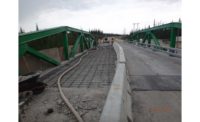After nearly three years of work in conditions that included stretches of frigid, sunless days, Canada’s first all-weather highway to its Arctic Coast is on track for completion later this year.
Funded by Canada’s federal government and the Northwest Territories, the 85.7-mile, $222-million two-lane gravel highway will connect the frontier town of Inuvik with the 900-person coastal hamlet of Tuktoyakyuk. It will eliminate seasonal reliance on an ice road atop the Mackenzie River, the only overland link when the ice becomes thick enough to support heavy vehicles.
Much of the route snakes through treeless tundra with sensitive underlying permafrost, so most construction since January 2014 has taken place during 166-day winter seasons. Up to 600 workers from EGT Northwind, a joint venture of two Inuvialuit-owned companies, worked virtually non-stop during those periods in sub-zero temperatures. Crews in Inuvik and Tuktoyakyuk worked toward each other, linking up in April 2016.
With ground conditions precluding typical cut-and-fill grading, embankments for the 26-ft to 29-ft-wide roadway and its 3:1 side slopes were formed using nearly 205 million cu ft of carefully sourced fill material, with a geotextile fabric placed atop the existing ground surface. Short-span, single-lane bridges have been constructed at eight stream crossings.
Remaining tasks include gravel surfacing and installation of signs and guardrails. The official opening is slated for mid-November.
The project was first planned in the 1960s, following the installation of Cold War radar systems at Tuktoyakyuk. Used as a resupply base for military personnel, the village supported undersea oil and natural-gas exploration activities through the 1990s. The highway is expected to make on-shore petroleum exploration activity more attractive by lowering logistics costs and increasing the quality of life for Tuktoyaktuk residents.




Post a comment to this article
Report Abusive Comment